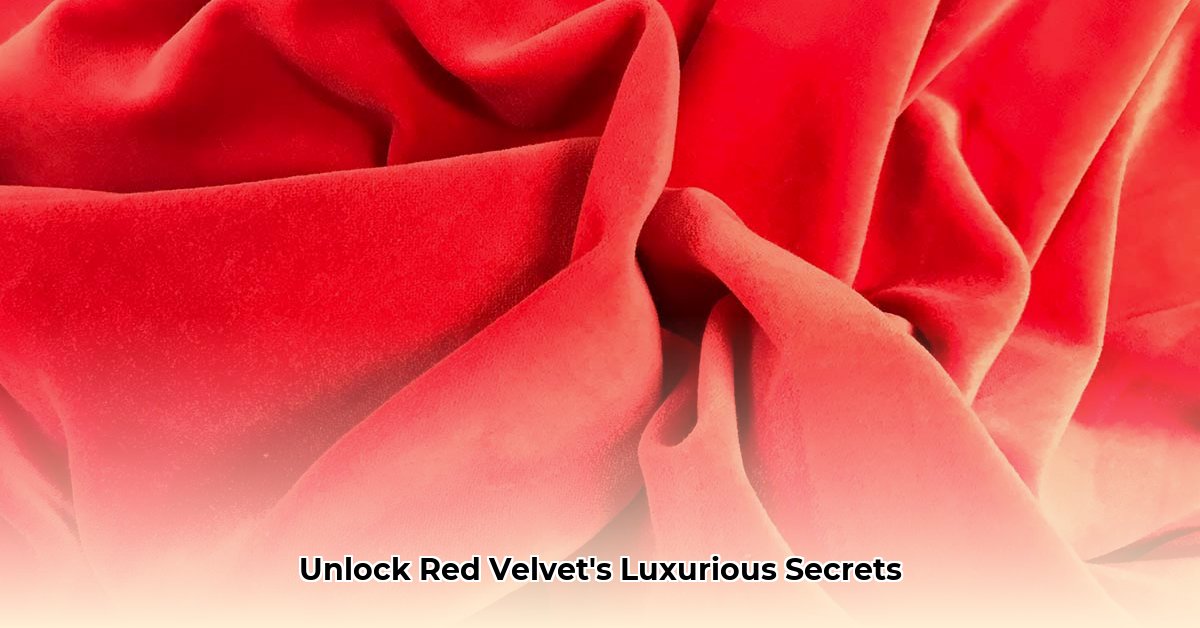Red velvet, a fabric synonymous with luxury and elegance, boasts a rich texture and deep color that captivates. But beyond its aesthetic appeal, what constitutes this remarkable material? This guide delves into the world of red velvet, exploring its composition, styles, applications, and sustainable options. For a wider selection, check out red velvet fabrics.
Understanding the Composition and Weave of Red Velvet Material
Velvet, as a category, is defined by its distinctive pile – closely packed, short fibers that create a soft, plush surface and a unique sheen. This pile gives velvet its signature look and feel. The type of fiber used significantly impacts the final product’s characteristics, influencing its drape, durability, and cost. Understanding common weave types and fabric blends helps to highlight red velvet material. In general, material selection hinges on fiber choices.
- Silk velvet: Known for its luxurious drape, deep color, and soft texture, silk velvet is the most premium option. However, it’s also delicate and requires professional cleaning. Silk red velvet is often used for high-end dresses and formal wear.
- Cotton velvet: A more durable and breathable alternative to silk, cotton velvet offers a balance of luxury and practicality, making it suitable for various applications. Cotton red velvet is a popular choice for upholstery and home decor.
- Synthetic velvets: Typically made from rayon or polyester, synthetic velvets are the most affordable option and offer easy care. However, they may lack the depth of color and texture found in natural fiber velvets. Polyester red velvet is frequently used for costumes and less expensive home accents.
These variables determine red velvet material’s efficacy for various usages. How does the fiber selection process work? It starts with understanding the unique attributes of each fiber.
Styles and Finishes of Red Velvet Material: Explore the Varieties
Beyond the basic fiber types, red velvet comes in various styles and finishes, each with its unique characteristics and best uses. The manufacturing process and finishing touches significantly impact the fabric’s final appearance and feel.
- Crushed velvet: This type has a deliberately rumpled appearance, giving it a unique, casual elegance that is more relaxed and less formal, perfect for adding texture and visual interest. Crushed red velvet is often seen in vintage-inspired clothing and bohemian home decor.
- Stretch velvet: With added elasticity, stretch velvet is ideal for clothing that requires a comfortable, well-fitting garment, allowing for greater freedom of movement. This style is particularly popular for dancewear and form-fitting dresses.
- Embossed velvet: This style features a pattern pressed into the velvet, creating a textured design. Embossed red velvet can add a sophisticated touch to upholstery and decorative items.
- Burnout velvet: A technique where parts of the velvet pile are removed to create a semi-transparent design. Burnout red velvet is frequently used in evening wear and scarves.
- Velveteen: This cotton fabric mimics the look and feel of velvet but has a shorter pile. Red velveteen is a budget-friendly alternative to velvet, often used in children’s clothing and linings.
These various styles can be incorporated into countless applications. The versatility of red velvet is truly remarkable.
Applications of Red Velvet Material
The beautiful color and texture of red velvet make it a top choice for various applications in fashion and interior design. From clothing to home décor, red velvet adds touch and dimension.
- Fashion: Red velvet is used in tailored jackets, sweeping maxi dresses, and elegant evening gowns, showcasing its ability to drape beautifully and create sophisticated styles. It is a popular choice for holiday attire and special occasion wear.
- Interior Design: Red velvet adds a touch of old-world glamour to any space, whether used for upholstery, curtains, or decorative throw pillows, elevating the room’s ambiance. It is often used in living rooms, bedrooms, and dining rooms to create a luxurious feel. Consider the impact of color psychology when designing these spaces.
“Red velvet is often associated with feelings of passion, confidence, and luxury,” says Emily Carter, Lead Designer at Carter & Co. Interiors. “Using it strategically can create a focal point and elevate the overall aesthetic of a space.”
Red velvet is also prevalent in theatrical costumes, accessories like handbags and shoes, and even craft projects.
Choosing Your Red Velvet Material: A Quick Guide for Decision-Making
Selecting the right red velvet requires careful consideration of its intended use and budget. The fiber type, style, and care requirements are key factors to consider.
| Fiber Type | Pros | Cons | Best Suited For |
|---|---|---|---|
| Silk | Super luxurious, deep color, drapes beautifully | Delicate, pricey, needs professional cleaning | High-end fashion, special occasion items |
| Cotton | Durable, breathable, reasonably priced | Might not have the same shine | Upholstery, curtains, many clothing items |
| Synthetic | Affordable, easy to find, easy care | Might not have the same richness of texture | Budget-friendly clothing, home décor |
Always check the care label before buying to understand the cleaning and maintenance requirements of your red velvet item. Consider also the weight of the fabric, as heavier velvets are better suited for upholstery and drapery, while lighter velvets are ideal for clothing.
Maintaining Your Red Velvet Material: Simple Steps to Long-Lasting Beauty
Proper care is essential to keeping your red velvet looking its best for years. Dry cleaning is generally recommended, especially for silk velvets. It is key to preserve its beauty and prevent damage.
- Follow the manufacturer’s care instructions.
- Avoid harsh chemicals and rigorous scrubbing. Instead, opt for gentle steaming to remove wrinkles.
- Store red velvet items in a cool, dry place, away from direct sunlight to prevent fading.
- Use a soft brush to remove dust and lint regularly.
- Treat gently to preserve its beauty and prevent damage.
For spot cleaning, test a small, hidden area first.
The Future of Red Velvet Material: Sustainable Textiles
The future of red velvet lies in sustainability, as consumers increasingly seek eco-friendly options. This is due to how more and more people are looking for eco-friendly options, pushing manufacturers to find sustainable ways to dye fabrics and source fibers to reduce the environmental impact of textiles. Ongoing research into sustainable dyes and materials will further shape the textile industry and its impact on the environment. What innovative technologies will manufacturers pioneer in the coming years?
Consider fabrics made from recycled polyester or organic cotton. Sustainable dyeing methods, such as using natural dyes or water-efficient techniques, are becoming more prevalent.
In conclusion, red velvet remains a timeless fabric with a special appeal. Its luxurious texture and rich color make it a beloved choice for designers and homeowners alike, ensuring its continued popularity for years to come.
How to Choose Sustainable Red Velvet Fabric for Upholstery
Velvet upholstery offers diverse choices based on fiber (silk, cotton, polyester), weave, and texture (crushed, embossed). Sustainability hinges on fiber sourcing and manufacturing. Understanding the market helps to choose.
Key Takeaways:
- Velvet upholstery offers diverse choices based on fiber (silk, cotton, polyester), weave, and texture (crushed, embossed).
- Sustainability hinges on fiber sourcing and manufacturing. Eco-friendly options like recycled, organic, and upcycled velvets are growing.
- Red velvet’s enduring popularity stems from its luxurious feel and visual appeal.
- Certifications (GOTS, RCS, OEKO-TEX) help identify eco-conscious products.
Understanding Velvet Types and Their Properties
How to choose sustainable red velvet fabric for upholstery requires the consumer to understand its environmental impact. Traditional velvet often uses synthetic fibers derived from fossil fuels. Choosing the right velvet depends on your needs. Durability, measured in “rub counts,” and fiber choices go hand-in-hand.
Consider the end-of-life of the fabric. Can it be recycled or composted?
Sustainability: A Deep Dive into Eco-Friendly Options
Fortunately, sustainable alternatives are emerging. Recycled polyester, organic cotton, and upcycled velvet are gaining traction, reducing reliance on extraction of fossil fuels. Look for certifications such as GOTS (Global Organic Textile Standard), RCS (Recycled Claim Standard), and OEKO-TEX Standard 100 to ensure eco-friendly production.
Explore innovative materials like Piñatex (pineapple leaf fiber) or fabrics dyed with natural pigments.
Red Velvet: Trends and Considerations
Crushed velvet is a notable textural trend due to its appeal and timeless look. Different shades and textures add to its versatility, as well. Further market research could reveal more about current trends in color palettes, patterns, and textures.
Consider the environmental impact of shipping and packaging when purchasing red velvet fabric.
Actionable Steps for Choosing Sustainable Red Velvet
- Define your priorities: Durability, softness, budget, and sustainability goals guide your fabric choice.
- Research fiber content: Opt for recycled polyester, organic cotton, or equivalent.
- Check for certifications: Look for labels like GOTS, RCS, or OEKO-TEX Standard 100.
- Compare suppliers: Evaluate sustainability practices and transparency.
- Consider the weave: A tighter weave usually means greater durability.
- Assess the texture: Choose a texture that fits your style and intended use.
Red Velvet Fabric in Home Decor: Upholstery and Drapery Applications
The material is popular due to its versatility and luxurious feel. Diverse fiber blends (silk, cotton, polyester) offer varying price points and durability, ultimately impacting
- Gray Kitchen Backsplash Tile: Ideas for a Stylish Upgrade - December 14, 2025
- Backsplash For Gray Cabinets: Choosing the Right Backsplash Style - December 13, 2025
- Gray And White Backsplash: Ideas For Timeless Style - December 12, 2025









